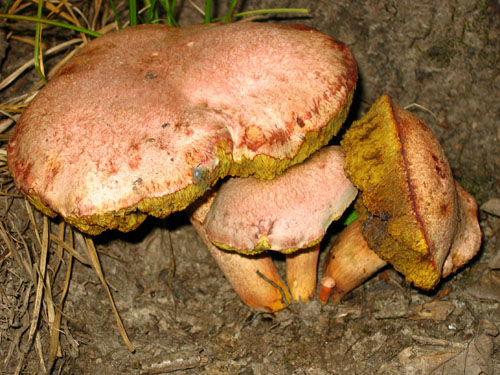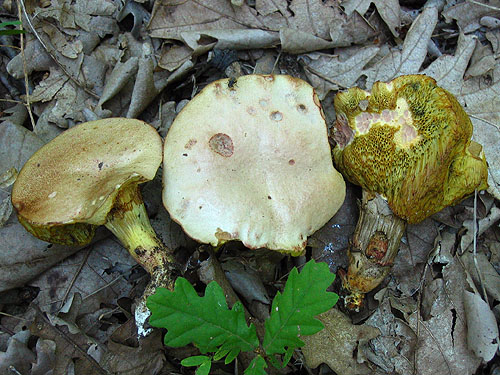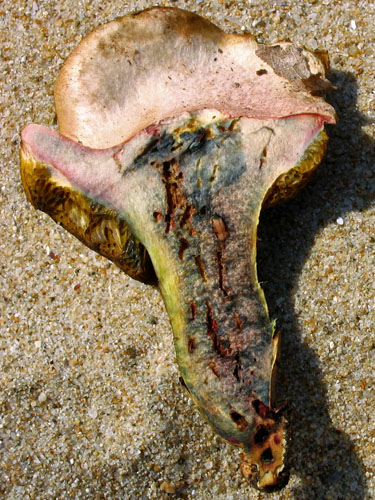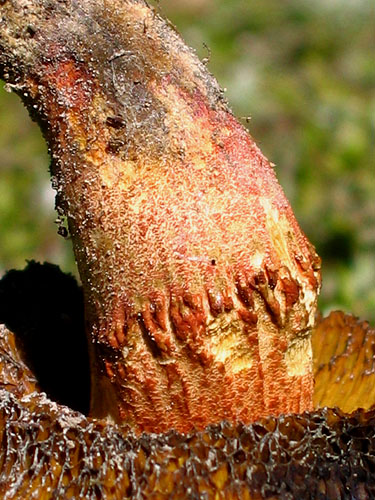Xerocomus Quél.
Recent molecular studies have shown that Xerocomus in its current circumscription is likely an artificial grouping and it is possible that it will be split at some point into smaller genera. Molecular studies also have changed our understanding about the species of xerocomoid boletes showing that morphological features are quite variable in this group. Not only microscopic study is essential for determination, but scanning electron microscope will be often needed in this “genus” as the spore ornamentation is not always seen under ordinary light microscope. Do bear in mind that macroscopic characters, such as colours, cracking cuticle, etc., tend to intergrade between the different species. Note that Boletus impolitus and Boletus depilatus that were shown to be close to Xerocomus subtomentosus and its allies, are here retained in Boletus for practical reasons. The same applies also for Phylloporus pelletieri, placed here in a genus of its own, but being also close to Xerocomus subtomentosus group.
Although large reference list will be found under most of the species, one should always consult Ladurner & Simonini (2003) having in mind that there are some new species (X. chrysonemus, X. marekii, X. silwoodensis) described after this otherwise superior book was printed. Useful keys, covering most of the European xerocomoid boletes (except some southern taxa) are provided by Knudsen & Vesterholt (2008), Hills (2008) and Kibby (2011), the later also featuring an excellent comparison chart.
Fruitbody medium to small sized, boletoid, without veil and ring. Some southern species have secondarily angiocarpic development and then a ring of coarse granules is observed on the stipe, where the cap margin was initially attached. Stipe solid, often tapering towards the base. Flesh variously coloured, changing or not when exposed to air. Tubes not separable from each other, instead tearing apart. Pores usually angular.
Xerocomus roseoalbidus Alessio & Littini
Description
Fruitbodies single or often clustered in groups of 3–7. Cap up to 7 cm, at first hemisphaerical, then convex, finally flat-convex, flat or slightly depressed, finely tomentose, then glabrous or somewhat fibrilose, sometimes finely cracked, at first whitish, usually with some pale pinkish tint or pinkish or reddish spots, then pink or rose, sometimes reddish when old, unchanging when bruised. Stipe tapering or spindle-shaped, somewhat rooting; yellowish or pale yellow, usually discoloring with the age, with fine yellow, orange yellow orange, dark orange or orange red granules, reddish orange to red in the same base; stipe surface not blueing or blueing after rough handling. Reticulum absent, but ring-like pattern of coarse granules may present on the stipe surface. Flesh lemon yellow in the stipe, paler in the cap and at least above the tubes and below the pileipellis pinkish, but mostly pinkish overall in the cap, intensively blueing when exposed to the air. Tubes lemon yellow when young, then with somewhat olivaceous tint, blueing when injured. Pores angular, concolorous with the tubes, blueing when bruised. Smell not distinctive. Taste not distinctive. Spores 11–17 × 5.5–8 μm, smooth. Pileipellis (cap cuticle) a trichoderm of interwoven branched septate, thin-walled and thick-walled hyphae, terminal cells 21.5–44 × 5.5–8.5 μm, ratio 2.8–6.8.
Habitat. In warm broadleaf forests, mycorrhizal with oaks (Quercus).
Distribution. Not yet fully understood, but as far as currently known, Xerocomus roseoalbidus is a southern species. Records are known from Bulgaria, Greece, Italy (incl. Sicily and Sardegna), France (Corsica) and Spain (incl. Balearic Islands). It has been recently mentioned from Hungary (Károly 2006), but such a northern record would require further confirmation. Some photographs available on the internet suggest that in east it reaches as far as Israel.
Note. Sometimes referred to as Rubinoboletus roseoalbidus (or ‘roseo-albus‘), but as far as known to me this name has never been validly published.
Photographs

Fruitbodies of Xerocomus roseoalbidus. Note the clustered grouth that is very typical for this species. (photo B. Assyov)

Older fruitbodies of Xerocomus roseoalbidus. (photo B. Assyov)

Fruitbodies of Xerocomus roseoalbidus. (photo B. Assyov)

Pale coloured fruitbodies of Xerocomus roseoalbidus. (photo B. Assyov)

Section of Xerocomus roseoalbidus. Note the blueing and the characteristic pinkish colour of the flesh in the cap. (photo B. Assyov)

Ornamentation of the stipe of Xerocomus roseoalbidus. The ring of coarse granules is typical for this bolete. (photo B. Assyov)

Apart from its macroscopic features Xerocomus roseoalbidus is also distinguished by its wide spores. Scale bar = 10 μm. (photo B. Assyov)
Important literature
Alessio, C.L. 1987. Xerocomus roseoalbidus sp. nov. – Mycologia Italiana 16(1): 15–21. (available online on site)
Alessio, C.L. 1991. Supplemento a Boletus Dill. ex L. (sensu lato). – In: Fungi Europaei. Vol. 2A. Pp. 1–126. Libreria editrice Biella Giovanna, Saronno.
Assyov, B. & Denchev, C.M. 2009. Boletus roseoalbidus (Boletaceae) – a rare southern bolete in Bulgaria. – In: Denchev, C.M. [Ed.] New records of fungi, fungus-like organisms, and slime moulds from Europe and Asia: 14–19. – Mycologia Balcanica 6: 169–173. (available online)
Engel, H., Dermek, A., Klofac, W., Ludwig, E. & Brückner, T. 1996. Schmier – und Filzröhrlinge s. l. in Europa. Die Gattungen Boletellus, Boletinus, Phylloporus, Suillus, Xerocomus. Verlag Heinz Engel, Weidhausen b. Coburg.
Estadès, A. & Lannoy, G. 2004. Les bolets européens. – Bulletin Mycologique et Botanique Dauphiné-Savoie 44(3): 3–79.
Galli, R. 1998. I Boleti. Atlante pratico-monographico per la determinazione dei boleti. Edinatura, Milano.
Károly, E. 2006. Adatok Zemplén védendõ nagygombáiról. – Folia Historico Naturalis Musei Matrensis 30: 399–405. (available online)
Ladurner, H. & Simonini, G. 2003. Xerocomus s.l. – In: Fungi Europaei. Vol. 8. Pp. 1–527. Edizioni Candusso, Alassio.
Lannoy, G. & Estadès, A. 2001. Les Bolets. Flore mycologique d’Europe. Documents Mycologiques Mémoire Hors série no. 6. Pp. 1–163. Association d’Écologie et de Mycologie, Lille.
Κωνσταντινίδης, Γ. 2009. Μανιτάρια, φωτογραφικός οδηγός μανιταροσυλλέκτη. Αυτοέκδοση, Αθήνα. [Konstantinidis, G. 2009. Mushrooms, a photographic guide for collectors. Published by the author, Athens.]
Polemis, E., Dimou, D.M., Tzanoudakis, D. & Zervakis, G.I. 2012. Annotated checklist of Basidiomycota (subclass Agaricomycetidae) from the islands of Naxos and Amorgos (Cyclades, Greece). – Annales Botanici Fennici 49: 145–161. (available online)